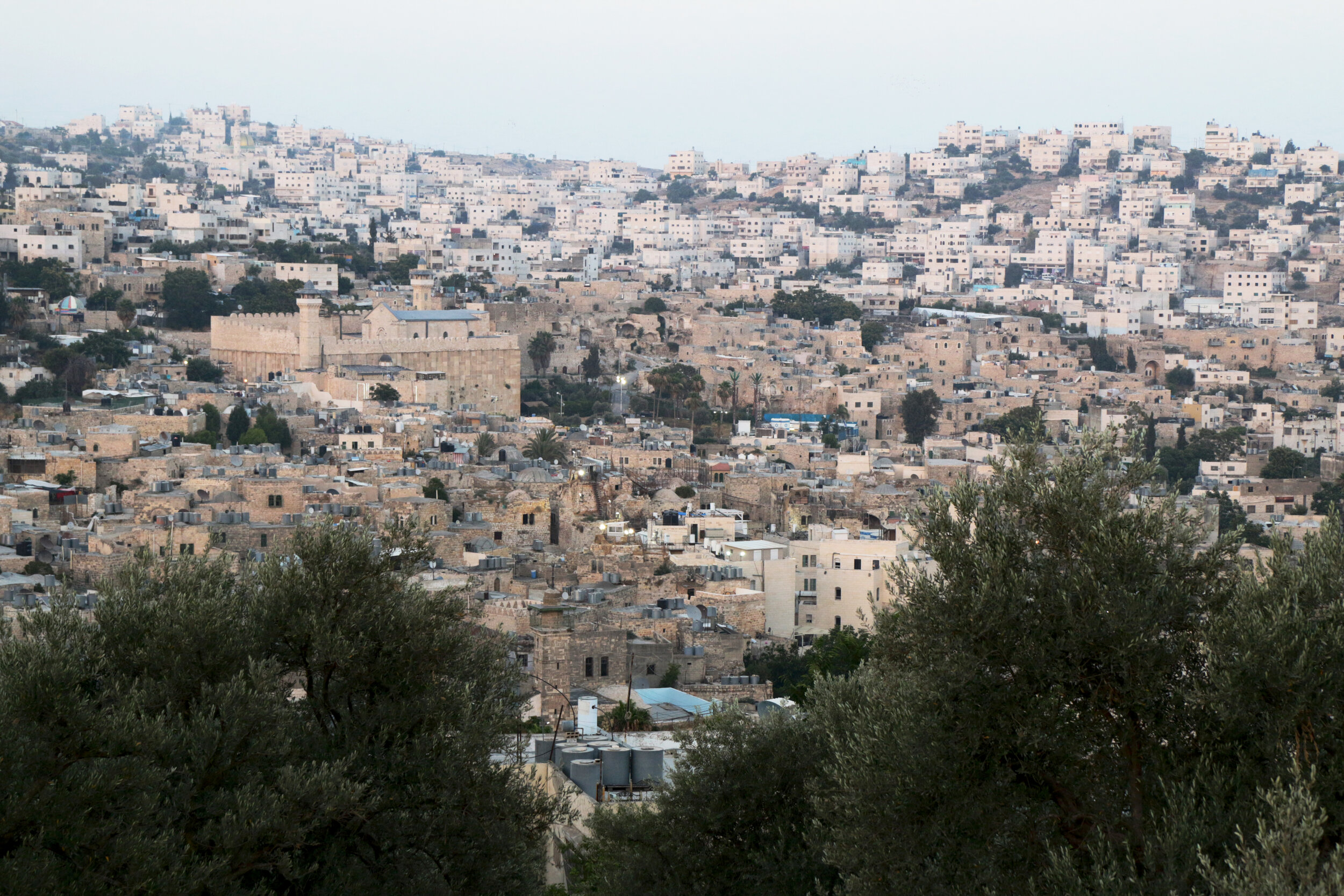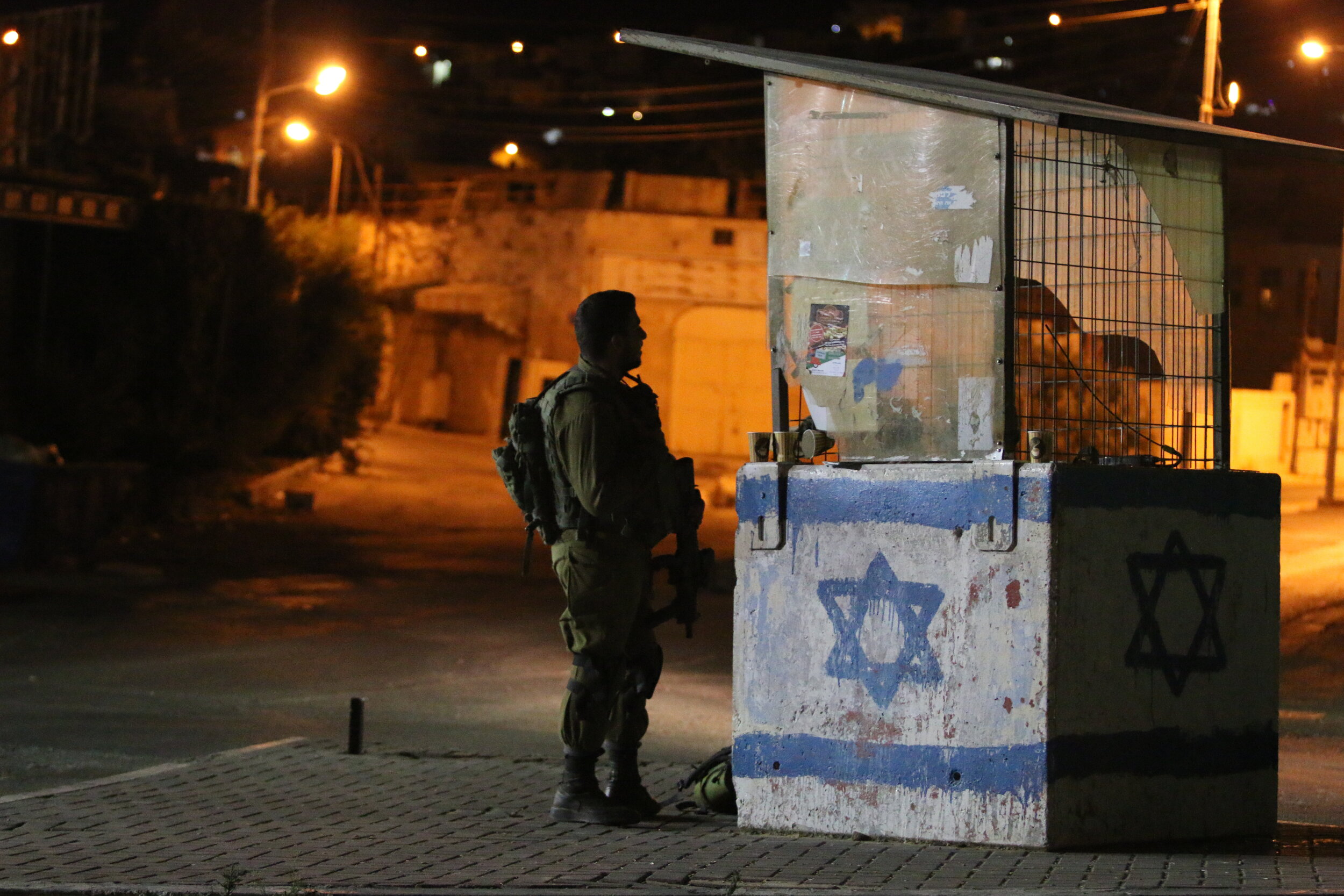Thousands of Jewish worshippers pack Hebron to celebrate the life of Sarah
A view of the Cave of the Patriarchs, at left with the two towers, in the Old City section of Hebron. Photo by Micah Danney.
HEBRON, Israel — Some 30,000 Israeli, American, British and French Jews thronged Hebron and the adjoining town of Kiryat Arba on Nov. 22 and 23 to celebrate the Torah reading of Chayei Sarah, which details how Abraham the Patriarch purchased a double cave in which to bury his wife Sarah.
The Cave of the Patriarchs is called Ma’arat ha-Machpela in the Hebrew Bible. To Muslims, who revere Abraham as a prophet and father of Ishmael, it is al-Masjid al-Ibrahimi (the Abraham Mosque). The shared complex is a source of religious and political tensions, making this holiday a cross between a Hasidic farbrengen (gathering), Woodstock, Thanksgiving and a large-scale operation of the Israel Defense Forces and police.
Jewish worshippers camped out on and around the grounds of Ma’arat ha-Machpela last week. Photo by Gil Zohar.
The city of the patriarchs and matriarchs has no Israeli-owned hotels and only one kosher eatery. The city is often cited as the most contentious of Israel’s settlements in the West Bank.
It is the largest Palestinian city in the territory, with more than 200,000 residents. A small community of about 800 Israelis live in the area near Ma’arat ha-Machpela, protected by a battalion of Israeli soldiers.
“Coordinating Shabbat is a major production,” said Rabbi Daniel Rosenstein, executive director of the Hebron Fund, a New York-based charity founded in 1979 which raises funds to improve life for Hebron’s Jewish residents, including building parks and playgrounds.
Worshippers camped out, slept in caravans and mobile homes, and placed mattresses on floors of private homes and public institutions everywhere. Tents were set up for free meals provided by several donors, who requested anonymity.
Apart from praying and feasting, the festivities – organized by the Hebron Fund, Chabad Hebron, Women in Green, and various other NGOs – included walking tours and lectures in English and Hebrew.
“Hebron is for lovers,” said Yishai Fleisher, spokesman for the Hebron Fund, referring to the romance between Abraham and Sarah, and Abraham’s decision to bury his beloved wife at the site. According to ancient tradition, it marks the sealed entrance to the Garden of Eden. Fleisher said the Ma’arat ha-Machpela features “the mystery of Stonehenge, the beauty of the Taj Mahal, and [has] a value to humanity which is unequalled.”
That spiritual enthusiasm was shared by many of the pilgrims. Shlomo Cohen, 19, of Toms River, New Jersey, who is spending a year at Jerusalem’s Mir Yeshiva, said, “I’m here to see the experience of so many Jews getting together for the jahrzeit of Sarah, and hopefully daven a lot.”
An Israeli soldier stands at a post in the H2 area of Hebron. Photo by Micah Danney.
This year’s Orthodox Jewish fête – exceeded only by the mass pilgrimage to the grave of Rabbi Nahman of Bratzlav in Uman, Ukraine during Rosh Hashana and the Lag b’Omer celebration at the tomb of the Rabbi Shimon Bar Yochai in Meron – passed without violence. In 2015, Cedarhurst, New Jersey student Eli Borochov, 21, was wounded in the groin by a sniper as he exited the Ma’arat ha-Machpela. Keeping a vow to return, Borochov and his brother Yosef and father Ronen again celebrated Chayei Sarah in Hebron.
Several thousand soldiers were positioned in visual and radio contact throughout the Israeli-controlled part of Hebron and along the 2-kilometer route linking the city’s Jewish quarter with the neighboring Israeli settlement of Kiryat Arba, population 5,000. Many of the celebrants stopped to wish each soldier “Shabbat shalom” and to offer them candy.
Demonstrating the esteem with which Hebron’s Jews hold the IDF, the crowd started singing the military’s ceremonial “IDF March” when Major General Roni Numa was called up to read from the Torah in the Isaac Hall, the section of the building reserved for Muslim worshippers. Numa is head of the IDF’s Central Command, which holds jurisdiction over the West Bank, which many Israelis call Judea and Samaria.
The Sabbath of Chayei Sarah is one of the 10 days annually in which Jews are permitted to enter and pray in the Isaac Hall, which houses the monuments to Isaac and his wife Rebecca. (The underground burial cave is off limits). The other half of the 2,000-year-old mausoleum built by King Herod the Great, which includes cenotaphs to Abraham and his wife Sarah, and Jacob and his wife Leah, is open to Jews year-round.
Notwithstanding that the Ma’arat ha-Machpela is the cradle of Jewish civilization, for 13 centuries of Muslim and Crusader rule until Israeli entrance during the 1967 Six-Day War, Jews were forbidden from entering the shrine. The current security arrangements were implemented following Dr. Baruch Goldstein’s February 25, 1994 shooting spree in the Ibrahami Mosque that killed 29 Muslim worshippers.
Hebron was the last of the seven West Bank cities that Israeli troops were redeployed from as a result of the 1993 Oslo Accords between Israel and the Palestine Liberation Organization. In 1997, under a long-delayed agreement signed between Israeli Prime Minister Benjamin Netanyahu and Palestinian Authority President Yasser Arafat, 80 percent of the city, an area known as H1, was handed over to the PA.
The remaining section, known as H2, was retained by Israeli troops to protect Hebron’s 91 Jewish families and several hundred students at Yeshivat Shavei Hevron, who live in a series of historic buildings and courtyards in the old city clustered around the Tomb of the Patriarchs and near the Middle Bronze Age site of Tel Hebron.
An IDF base overlooks the H2 area of Hebron from a hilltop. Photo by Micah Danney.
Those Jews, protected by some 1,000 IDF soldiers and Border Police, see themselves as the vanguard of the Jewish people keeping a toehold in the ancient city, where the patriarchs and matriarchs lived and were buried, and where King David ruled for seven years before moving his capital to newly-liberated Jerusalem. They see themselves as re-establishing an ancient community that temporarily came to an end with the 1929 pogrom which left 67 Jews murdered and mutilated.
Most of the 30,000 Arabs with homes and businesses in Israeli-controlled H2 have moved to the other side of the security fence where they are not subject to daily harassment by settlers and IDF soldiers. Their shuttered properties, including 1,800 stores with metal doors welded shut, and the heavy presence of soldiers give Hebron’s Jewish quarter a spooky, post-apocalyptic appearance.
Israeli law forbids Israelis from moving into more homes in the Jewish Quarter, which still has many Arab residents. The area is frozen as a ghostly urban wasteland.
Armored buses offer an umbilical cord connecting Hebron to Jerusalem 18 miles north.
Hebron is one of the four ancient holy cities of the historical Land of Israel, which also include Jerusalem, Safed and Tiberias.




